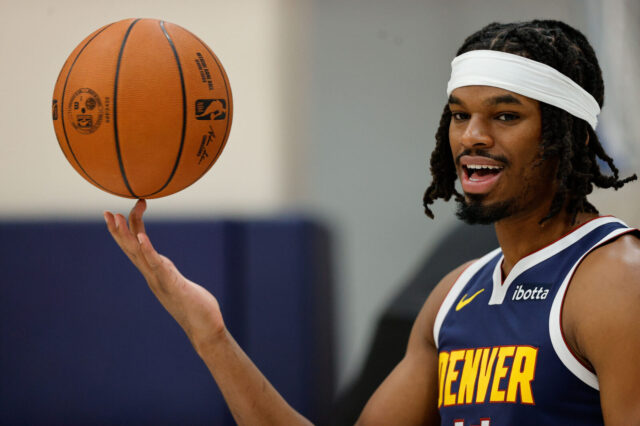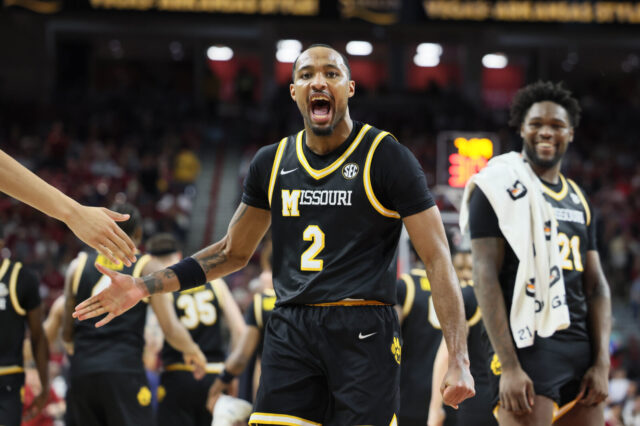So, the Denver Nuggets made a very interesting trade.
After a failed trade last week that involved sending Bol Bol to the Detroit Pistons, the Nuggets turned around and made a subsequent move, pairing Bol with PJ Dozier and a 2028 second round pick to acquire combo guard Bryn Forbes. It will be sad to see PJ Dozier leave, as he was nothing but a professional in Denver and was in line for a big contract before tearing his ACL. Hopefully, he receives the treatment and rehab he needs to get back on the court soon, because he’s fantastic. Bol…I hope he does well too.
But Denver going from moving Bol and acquiring value (2022 second round pick) in the failed Detroit deal and instead sending Bol along with other pieces to acquire a veteran shooter is a very interesting pivot. Bryn Forbes is a helpful player. He might become a mainstay in Denver’s backcourt rotation if he shoots well and fits in. He might simply be a reserve option at the end of the day, but Denver will at least know exactly what they’re getting when they play him. He’s a functional veteran, and the Nuggets acquired him for a reason.
Let’s talk about it:
Who is Bryn Forbes?
Forbes has been in the NBA for six seasons now. This is his sixth year, and he’s spent time with just two NBA organizations: the San Antonio Spurs and Milwaukee Bucks. For four seasons, Forbes went from a garbage time role within the Spurs to a full-time starter. He was a consistent floor spacer for Kawhi Leonard, DeMar DeRozan, and LaMarcus Aldridge, never shooting below 38.8% from three-point range after his rookie season. The Nuggets are of course familiar with Forbes’ time in San Antonio during the 2018-19 season. Forbes shot 48.4% from three-point range against Denver in their first round playoff series that the Nuggets won in seven games. In Game 7, Forbes had 19 points on 7-of-11 FG and 3-of-4 3P.
His lone season with the Milwaukee Bucks was focused on being a bench floor spacer. In 19.3 minutes per game, Forbes shot a ludicrous 45.2% from three-point range while playing next to players like Giannis Antetokounmpo, Khris Middleton, and Jrue Holiday. His shooting helped win the Bucks the occasional game, and his constant presence helped space the floor for the Bucks’ primary actions. He was part of Milwaukee’s playoff rotation all the way up to Game 4 of the NBA Finals, and he made at least one three-pointer in 15 of the 20 playoff games he played in.
This season, Forbes has been in the rotation for the Spurs once again, having signed a one-year deal with his first team after winning a ring in Milwaukee. Forbes’ role had fluctuated a lot over the last few weeks, and he didn’t play in each of the Spurs’ last couple of games as they look to offer more minutes to rookie Joshua Primo, among others.
What will Bryn Forbes do?
Shoot. Shoot. Shoot. If you look up the definition of shooter in the dictionary, Stephen Curry’s picture comes up, but Bryn Forbes is somewhere in the background too. For his career, Forbes is a 41.3% three-point shooter, averaging 7.3 threes attempted per 36 minutes, which is a significant amount. Among the 73 players to attempt as many threes as Forbes has in his NBA career (1,500+) Forbes has maintained the sixth highest three-point percentage in the NBA, just behind Steph Curry (41.5%) and ahead of Duncan Robinson (40.6%).
Forbes finds his three-pointers in a number of ways, the most notable being in transition and on relocations around the perimeter. He does a great job of finding the open space in the defense and capitalizing consistently, moving full speed or at no speed and staying shot ready all the time.
Forbes is utilizing over 21% of his scoring possessions in transition this year, and he averages 1.19 points per possession in transition despite being a small guard. His confidence pulling up from three in transition settings makes him viable on a fast break in a way that some small guards struggle with against a defender at the rim.
Forbes also has the ninth highest frequency in the NBA of his scoring play types that come off of screens, and that’s where he truly flourishes in the half court. Forbes averages 1.12 points per possession coming off screens this year, which ranks in the 81st percentile in the NBA and outpaces elite NBA shooters like Stephen Curry (1.09 ppp), Kevin Durant (1.09), Buddy Hield (1.08), and Zach LaVine (1.06). Now, this doesn’t necessarily mean Forbes is a better shooter than those guys, but it certainly puts him in a high quality class of shooter that the Nuggets just acquired with two players that weren’t going to play again this year. It doesn’t have to be from three-point range either, just wherever the space on the court is.
Forbes is also a functional player with the capability to take his eyes off the rim when it benefits the team. He only averages 1.0 assists per game, but there are some good reads of the defense that the Nuggets could certainly take advantage of.
What NOT to expect from Forbes is elite defense though. At 6’2” and undersized for the shooting guard position, Forbes is frequently put in compromising situations defensively, and that’s one of the major reasons why he hasn’t been a high minute player throughout his NBA career. He certainly plays a role, but that role will be limited in high pressure situations against teams that will hunt him down on the defensive end.
How will Bryn Forbes affect the Nuggets rotation?
This is the most intriguing part of the deal. The Nuggets would never have dealt PJ Dozier for anything less than a player that they want to contribute immediately. They’re generally averse to trading players just for improving on the margins, so they must believe Forbes can play a legitimate role.
The biggest question: who comes out of the rotation?
Monte Morris and Will Barton are entrenched as starters in the backcourt for now, and Jamal Murray is firmly on the way toward playing again after the All-Star break. Once Murray returns, the Nuggets will have their top three guards back in place, and eventually, that trio will make up the bulk of the minutes played at point guard and shooting guard.
Until Murray comes back though (and even when he does return) the Nuggets could use a player of Forbes’ caliber shooting on the perimeter consistently. Facu Campazzo, Bones Hyland, and Austin Rivers have played a combined 2,100 minutes so far this season in relatively consistent bench roles, and they’ve shot 32.2% (Campazzo), 31.8% (Rivers), and 34.1% (Bones) from three-point range so far. That just isn’t good enough to consistently warrant playing time in today’s NBA, and introducing an elite shooter into the mix will give Denver more combinations to play around with going forward.
The value of shooting can often be overstated, but a lack of shooting is a surefire way to destroy an offense. The Nuggets bench, in almost every single combination of minutes with Nikola Jokić sitting on the bench, has been impossibly bad for much of the season. Part of the reason is removing the dynamic shooting talent of Jamal Murray and Michael Porter Jr. from the equation as well. The Nuggets have been left with good shooters, average shooters, and bad shooters to mess around with, but no great shooters. Forbes is clearly the best shooter in the rotation by default, given his shooting percentages and track record in the NBA, until Murray and Porter return. That holds tangible value.
Will Forbes consistently play over rookie Bones Hyland? What about veteran Austin Rivers? Maybe Denver goes the untraditional route and plays Bones and Forbes together, removing Facu Campazzo from the rotation instead? There are lots of ways to manage things going forward, but it’s better to have options than not.
This trade, despite having to give up Dozier, was a no-brainer for the Nuggets if they believe Murray and Porter will be back soon. Adding a veteran shooter that’s used to a complementary role next to star players is a great way to solidify a playoff rotation. Forbes might not be perfect, but he should help out the Nuggets rotation tremendously, lifting up Denver’s collective performance by instilling some additional competence and competition in the backcourt.


